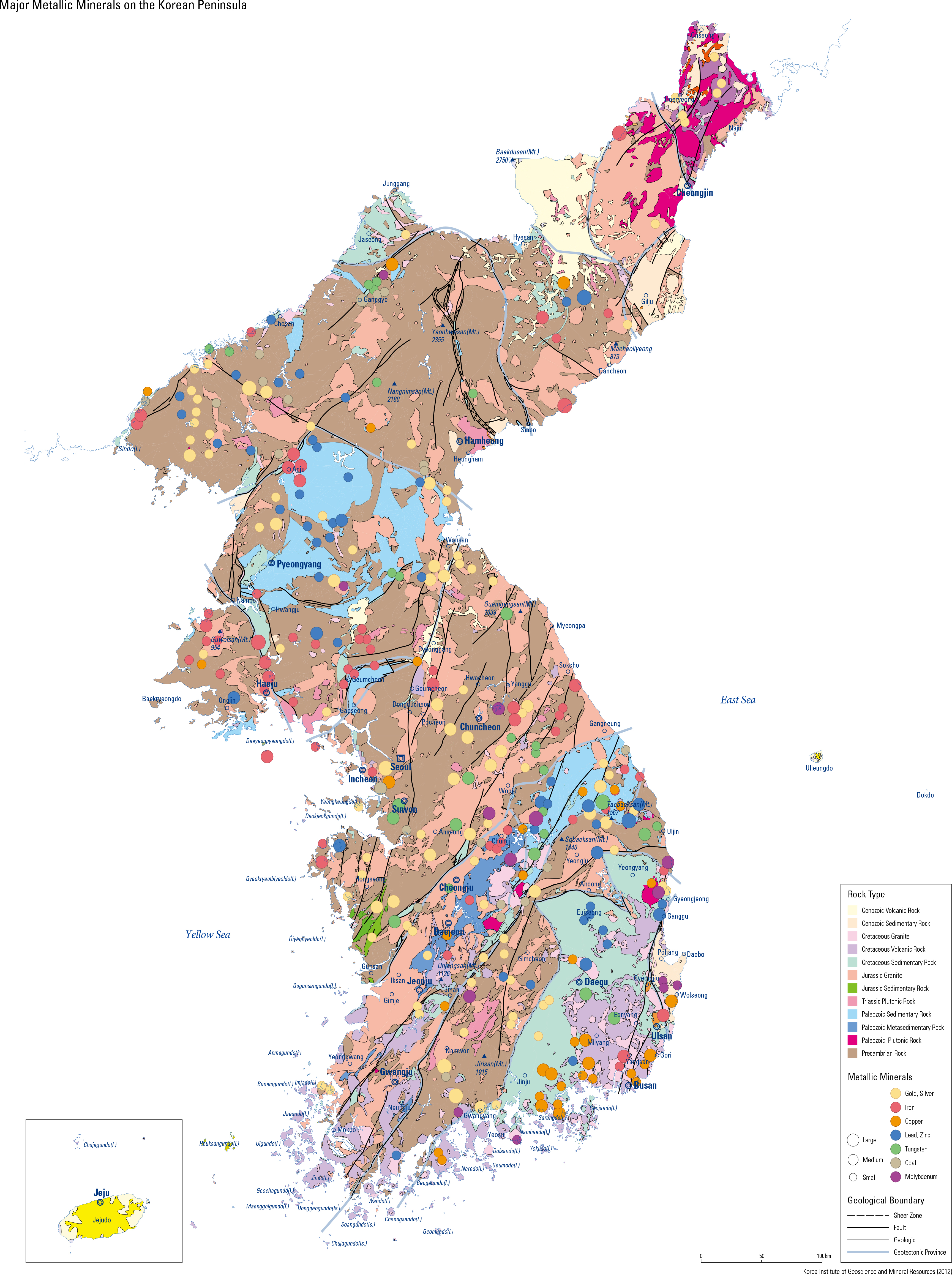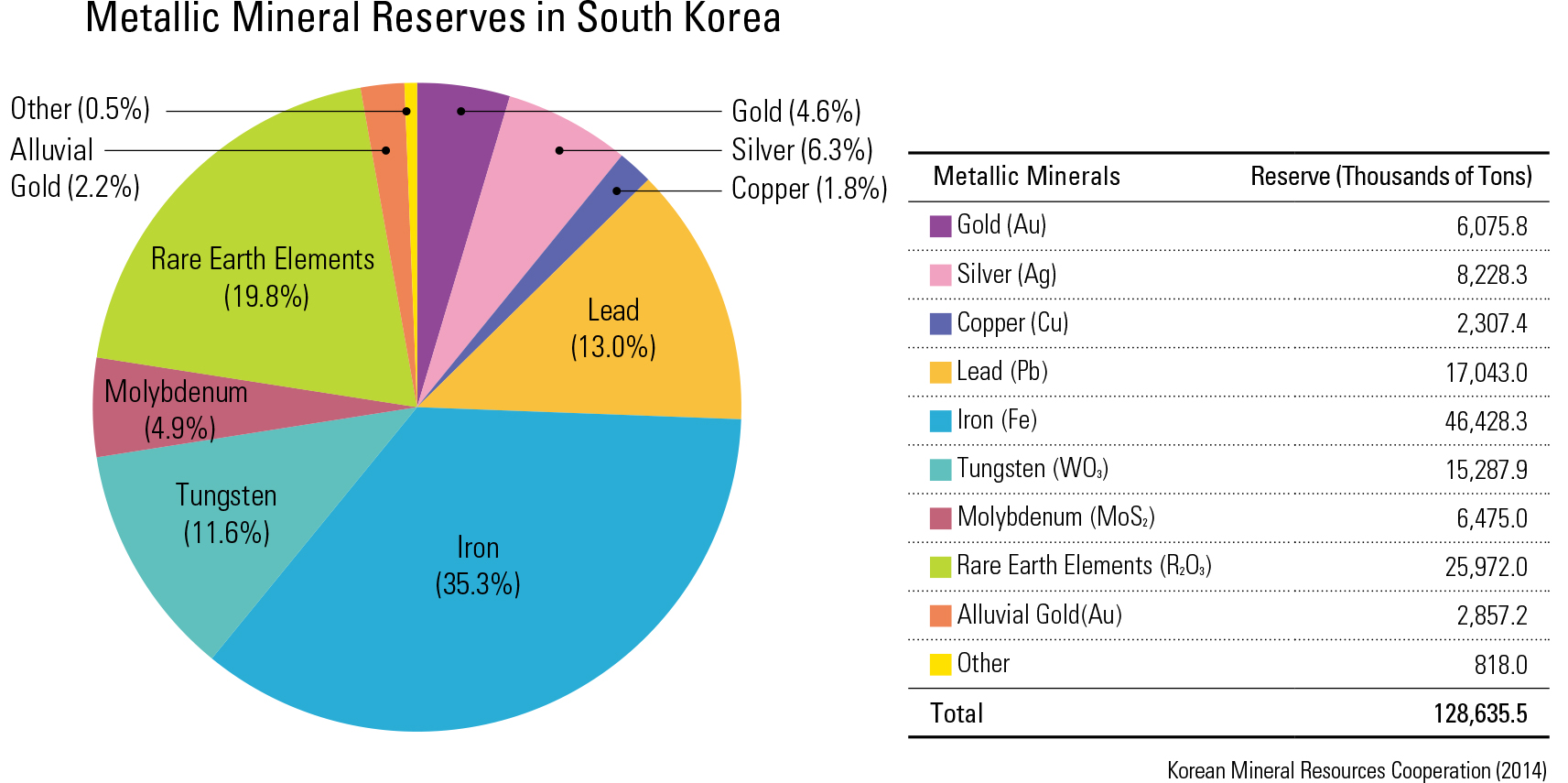English II
The main mineral resources in the Korean Pen- insula can be classified into metallic, nonmetal- lic, placer, fossil fuel, nuclear fuel, and building stone/aggregate resources. Metallic resources include gold, silver, copper, lead, zinc, iron, manganese, tungsten, molybdenite, tin, bismuth, antimonite, rare earth elements, and so forth. Nonmetallic resources include limestone, dolos- tone, quartz sand, quartzite, serpentine, feldspar, kaolinite, graphite, talc, pyrophyllite, diatomite, asbestos, uorite, mica, illite (sericite), andalusite, and so forth. Placer resources include placer gold, monazite, zircon, ilmenite, magnetite, and garnet. Anthracite and lignite are fossil fuel resources and uranium minerals are nuclear fuel resourc- es. Building stone/aggregate resources include granite, limestone, marble, shale, sandstone, and aggregates. The typical Precambrian banded iron forma- tion in Seosan and the Ti-bearing-iron deposit in Gonamsan-Soyeonpyeongdo-Boleumdo are Precambrian ore deposits. Tungsten, tin, and gold deposits in Bonghwa-Uljin-Sangdong area and ilmenite deposits in Hadong-Sancheong are the Precambrian deposits in the Yeongnam Massif. The iron deposits in the Chungju-Jungwon area are embedded around the Gyemyeongsan For- mation in the Ogcheon Supergroup and contain abundant rare earth elements. The uranium depos- its are embedded in the coal-rich black phyllite or schist throughout the large area of Chungju-Goe- san (Dukpyeong-Yuyong-ri-Miwon)-Boeun-Dae- jeon. As a fossil fuel, anthracite is embedded in the late Paleozoic Pyeongyan Supergroup and mid- dle Mesozoic Dadong Supergroup. The mining regions for Paleozoic anthracite are Samcheok, Pyeongchang, Boeun, and Boseong and mining regions for Mesozoic anthracite are Kimpo, Yeo- ncheon, Buyeo and Boryeong. The Mesozoic mine includes Jurassic pegmatite ore deposits in the Gyeonggi Massif which has feldspar, colum- bite-tantalite, molybdenite, uorite, uranium-bear- ing minerals, and beryl. The Jurassic and Creta- ceous gold and/or silver mines, as a representative mineral resource of the Korean Peninsula, are mostly vein ore deposits formed by the intrusion of hydrothermal uid into the fractures of the Me- sozoic granites and their surrounding rocks. Rep- resentative gold and/or silver mines are located in Mugeug, Bupyeong, Imcheon, Weolyu, Jeonjuil, Tongyeong, and Geochang. Another important mineral resource, tungsten-molybdenite, has also been formed near Mesozoic granites during Juras- sic and Cretaceous. At the same period, copper, lead, and zinc mines were forged by hydrother- mal alteration related to the Cretaceous igneous activity. Cretaceous iron mines are located in the Gyeongsang basin. Talc deposits formed by hy- drothermal metasomatism, are classi ed into two types: one type is ultrama c origin and includes the Pyeongdang and Cheongdang mines, and the other type is dolomite origin and includes the Dongyang, Pungjeon, and Chungju-Jaeil mines. The kaolinite-pyrophyllite mines were formed by hydrothermal alteration of tuff, felsite and andes- ite and are distributed in Gyeongsangnam-do and Jeollanam-do. Cenozoic deposits include Wondong mine in Samcheok, Dongjeom mine in Changyeong, Ge- umryeong mine in Wolseong. The mines are skarn and porphyritic deposits including various metals. The zeolite, bentonite, and acidic white clay de- posits occur along the tuff stratigraphic horizon within the Tertiary sedimentary formations around the Pohang-Guryongpo-Ulsan. The northern region of the Korean Peninsula, holds a wider variety of mineral resources than the southern region. The main mineral resources are magnesite, limestone, graphite, zinc, iron, gold, and anthracite. Archean banded iron de- posits are in Hamgyeongbuk-do and Neoprotero- zoic deposits are the Geomdeok zinc mine and Ryongyang and Daeheung magnesite mines in Hamgyeongnam-do and the Hyesan Cheongneon and Gabsan mines in Yanggang-do. Anthracite deposits are embedded in the Paleozoic sediments in Pyeongannam-do and 2·8 Jikdong is repre- sentative coal mine. Many coal mines are also developed in Hamgyeong-do. The mines related to Mesozoic igneous activity occur as skarn and vein type deposits associated with various miner- al resources including gold. Representative gold and silver deposits are in Pyeonganbuk-do and in Hwanghaebuk-do. Uranium deposits are reported from Suncheon in Pyeongannam-do and Pyeo- ngsan in Hwanghaebuk-do. Tungsten deposits have high reserves and include Mannyeon mine and the Jangjin mine in Hamgyeong-do, and the Beobdong and Goseong mines in Gangwon-do. Molybdenite mines include Ryonghong and Sakju mines in Pyeongannam-do and Gamuri and Yangam mines in Hwanghae-do and their re- serves are small sacle.
page_2 |



